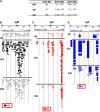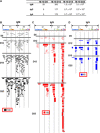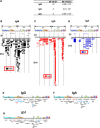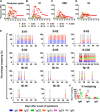Longitudinal antibody repertoire in "mild" versus "severe" COVID-19 patients reveals immune markers associated with disease severity and resolution
- PMID: 33674317
- PMCID: PMC7935365
- DOI: 10.1126/sciadv.abf2467
Longitudinal antibody repertoire in "mild" versus "severe" COVID-19 patients reveals immune markers associated with disease severity and resolution
Abstract
Limited knowledge exists on immune markers associated with disease severity or recovery in patients with coronavirus disease 2019 (COVID-19). Here, we elucidated longitudinal evolution of SARS-CoV-2 antibody repertoire in patients with acute COVID-19. Differential kinetics was observed for immunoglobulin M (IgM)/IgG/IgA epitope diversity, antibody binding, and affinity maturation in "severe" versus "mild" COVID-19 patients. IgG profile demonstrated immunodominant antigenic sequences encompassing fusion peptide and receptor binding domain (RBD) in patients with mild COVID-19 who recovered early compared with "fatal" COVID-19 patients. In patients with severe COVID-19, high-titer IgA were observed, primarily against RBD, especially in patients who succumbed to SARS-CoV-2 infection. The patients with mild COVID-19 showed marked increase in antibody affinity maturation to prefusion SARS-CoV-2 spike that associated with faster recovery from COVID-19. This study revealed antibody markers associated with disease severity and resolution of clinical disease that could inform development and evaluation of effective immune-based countermeasures against COVID-19.
Copyright © 2021 The Authors, some rights reserved; exclusive licensee American Association for the Advancement of Science. No claim to original U.S. Government Works. Distributed under a Creative Commons Attribution NonCommercial License 4.0 (CC BY-NC).
Figures






References
-
- Johns Hopkins University & Medicine Center for Systems Science and Engineering (CSSE) (2020), vol. 2020.
-
- Callaway E., The race for coronavirus vaccines: A graphical guide. Nature 580, 576–577 (2020). - PubMed
-
- Shen C., Wang Z., Zhao F., Yang Y., Li J., Yuan J., Wang F., Li D., Yang M., Xing L., Wei J., Xiao H., Yang Y., Qu J., Qing L., Chen L., Xu Z., Peng L., Li Y., Zheng H., Chen F., Huang K., Jiang Y., Liu D., Zhang Z., Liu Y., Liu L., Treatment of 5 critically ill patients with COVID-19 with convalescent plasma. JAMA 323, 1582–1589 (2020). - PMC - PubMed
-
- Roback J. D., Guarner J., Convalescent plasma to treat COVID-19: Possibilities and challenges. JAMA 323, 1561–1562 (2020). - PubMed
-
- Brouwer P. J. M., Caniels T. G., van der Straten K., Snitselaar J. L., Aldon Y., Bangaru S., Torres J. L., Okba N. M. A., Claireaux M., Kerster G., Bentlage A. E. H., van Haaren M. M., Guerra D., Burger J. A., Schermer E. E., Verheul K. D., van der Velde N., van der Kooi A., van Schooten J., van Breemen M. J., Bijl T. P. L., Sliepen K., Aartse A., Derking R., Bontjer I., Kootstra N. A., Wiersinga W. J., Vidarsson G., Haagmans B. L., Ward A. B., de Bree G. J., Sanders R. W., van Gils M. J., Potent neutralizing antibodies from COVID-19 patients define multiple targets of vulnerability. Science 369, 643–650 (2020). - PMC - PubMed
Publication types
MeSH terms
Substances
Grants and funding
LinkOut - more resources
Full Text Sources
Other Literature Sources
Medical
Miscellaneous

